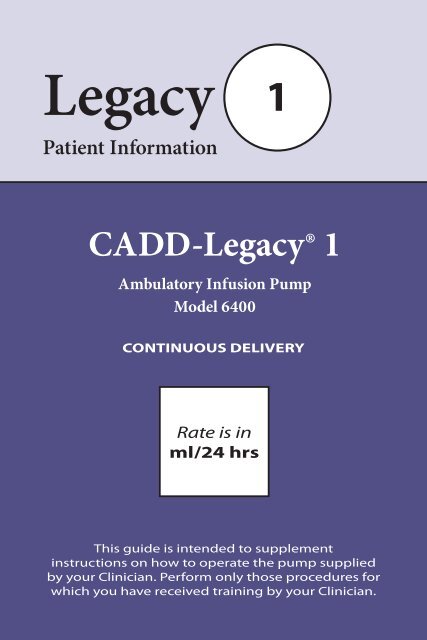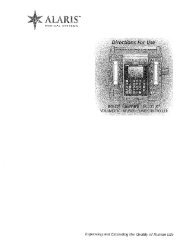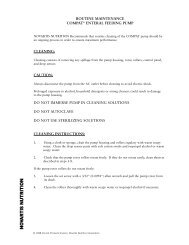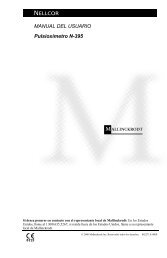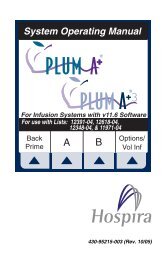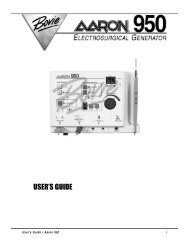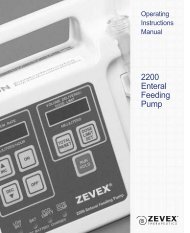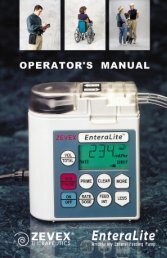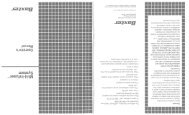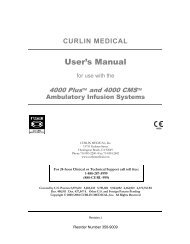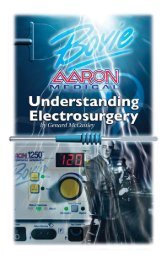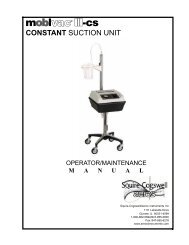CADD Legacy (6400) Patient Information
CADD Legacy (6400) Patient Information
CADD Legacy (6400) Patient Information
You also want an ePaper? Increase the reach of your titles
YUMPU automatically turns print PDFs into web optimized ePapers that Google loves.
<strong>Legacy</strong><br />
<strong>Patient</strong> <strong>Information</strong><br />
Rate is in<br />
ml/24 hrs<br />
1<br />
<strong>CADD</strong>-<strong>Legacy</strong>® 1<br />
Ambulatory Infusion Pump<br />
Model <strong>6400</strong><br />
CONTINUOUS DELIVERY<br />
This guide is intended to supplement<br />
instructions on how to operate the pump supplied<br />
by your Clinician. Perform only those procedures for<br />
which you have received training by your Clinician.
Table of Contents<br />
Introduction ........................................................................................... 1<br />
Warnings .................................................................................................. 2<br />
Cautions ................................................................................................... 4<br />
<strong>CADD</strong>-<strong>Legacy</strong>® 1 Pump (Diagram) ................................................. 5<br />
Description of the Keys ...................................................................... 6<br />
Installing New Batteries ..................................................................... 7<br />
Starting the Pump ................................................................................ 11<br />
Stopping the Pump ............................................................................. 12<br />
Turning the Pump On/Off ................................................................. 12<br />
Removing a Cassette ........................................................................... 13<br />
Attaching a Cassette ........................................................................... 14<br />
Resetting the Reservoir Volume ...................................................... 16<br />
Priming the Tubing Using the Pump ............................................. 17<br />
Inserting the Tubing into the Air Detector .................................. 18<br />
What if I drop or hit the pump? ....................................................... 20<br />
Messages and Alarms ......................................................................... 21
Introduction<br />
Your doctor has recommended that you use the<br />
<strong>CADD</strong>-<strong>Legacy</strong>® 1 pump as part of your treatment.<br />
The <strong>CADD</strong>-<strong>Legacy</strong>® 1 pump can be carried with you and is<br />
designed to deliver medication into your body. Your physician<br />
will prescribe your medication specifically for you. Your<br />
prescription is programmed into your pump by your clinician<br />
according to your physician’s specific orders.<br />
This patient guide pertains only to the <strong>CADD</strong>-<strong>Legacy</strong>® 1 Model<br />
<strong>6400</strong> ambulatory infusion pump. There are other <strong>CADD</strong>-<br />
<strong>Legacy</strong>® pump models available; review the rear label of the<br />
pump to ensure it is a <strong>CADD</strong>-<strong>Legacy</strong>® 1 Model <strong>6400</strong> pump<br />
before use. This pump delivers medication at a continuous<br />
rate in milliliters per 24 hours (ml/24hrs). The pump stores<br />
programmed and historical information that your clinician<br />
needs for your specific therapy.<br />
Your clinician will instruct you on the proper use of this pump.<br />
This guide is intended to supplement those instructions.<br />
Perform only those procedures for which you have received<br />
training.<br />
The following is a list of warnings and cautions that you should<br />
read before operating the pump. It is important that you<br />
understand and follow these warnings and cautions.<br />
1
Failure to properly follow warnings, cautions, and<br />
instructions could result in damage to the pump or death or<br />
serious injury.<br />
Warnings<br />
• If the pump is used to deliver life-sustaining medication, an<br />
additional pump must be available.<br />
• Use of a syringe with the <strong>CADD</strong> Administration Set<br />
may result in UNDER-DELIVERY of medication. Syringe<br />
function can be adversely affected by variations in plunger<br />
dimension and lubricity, which can result in greater force<br />
required to move the syringe plunger. A syringe plunger<br />
will lose lubrication as it ages and, as a result, the amount<br />
of under-delivery will increase which could on occasion, be<br />
significant.<br />
2<br />
You must regularly compare the volume remaining in the<br />
syringe to the pump’s displayed values such as Reservoir<br />
Volume or Given to determine if under-delivery is occurring<br />
and, if necessary, contact your clinician.<br />
• Do not use rechargeable NiCad or nickel metal hydride<br />
(NiMH) batteries. Do not use carbon zinc (“heavy duty”)<br />
batteries. They do not provide sufficient power for the pump<br />
to operate properly.<br />
• Always have new batteries available for replacement. If<br />
power is lost, non-delivery of medication will occur.<br />
• If the pump is dropped or hit, the battery door tabs may<br />
break. Do not use the pump if the battery door or tabs<br />
are damaged because the batteries will not be properly<br />
secured; this may result in loss of power and non-delivery of<br />
medication. Contact your clinician for further instructions.
• If a gap is present anywhere between the battery door and<br />
the pump housing, the door is not properly latched. If the<br />
battery door becomes detached or loose, the batteries will<br />
not be properly secured; this could result in loss of power<br />
and non-delivery of medication.<br />
• Prior to starting infusion, inspect the fluid path for kinks, a<br />
closed clamp, or other upstream occlusions, and remove all<br />
air bubbles to prevent air embolism.<br />
• Close the fluid path tubing with the clamp before removing<br />
the cassette from the pump to prevent unregulated gravity<br />
infusion.<br />
• If you are using a <strong>CADD</strong> Administration Set or Medication<br />
Cassette Reservoir that does not have the flow stop feature<br />
(catalog number does not start with 21-73xx): You must use<br />
a <strong>CADD</strong> Extension Set with an integral Anti-Siphon Valve<br />
or a <strong>CADD</strong> Administration Set with either an integral or an<br />
Add On Anti-Siphon Valve to protect against unregulated<br />
gravity infusion that can result from an improperly attached<br />
cassette.<br />
• For detailed instructions and warnings pertaining to the<br />
Medication Cassette Reservoir or <strong>CADD</strong> Administration Set,<br />
please refer to the instructions supplied with those products.<br />
• Attach the cassette (the part of the Medication Cassette<br />
Reservoir or <strong>CADD</strong> Administration Set that attaches to<br />
the pump) properly. An improperly attached or detached<br />
cassette could result in unregulated gravity infusion of<br />
medication from the fluid container or a reflux of blood.<br />
• Do not prime the fluid path with the tubing connected<br />
to your catheter. This could result in over-delivery of<br />
medication or air embolism.<br />
• Ensure that the entire fluid path is free of all air bubbles<br />
before connecting to your catheter to prevent air embolism.<br />
3
• If the pump is dropped or hit, inspect the pump for damage.<br />
Do not use a pump that is damaged or is not functioning<br />
properly. Contact your clinician for further instructions.<br />
Cautions<br />
• Do not operate the pump at temperatures below +2°C (36°F)<br />
or above 40°C (104°F).<br />
• Do not store the pump at temperatures below -20°C<br />
(-4°F) or above 60°C (140°F). Do not store the pump with a<br />
Medication Cassette Reservoir or <strong>CADD</strong> Administration Set<br />
attached. Use the protective cassette provided.<br />
• Do not expose the pump to humidity levels below 20% or<br />
above 90% relative humidity.<br />
• Do not store the pump for prolonged periods with the<br />
batteries installed.<br />
• Frozen medications must be thawed at room temperature<br />
only. Do not heat the Medication Cassette Reservoir in a<br />
microwave oven as this may damage the medication, the<br />
Medication Cassette Reservoir, or cause leakage.<br />
• Do not immerse the pump in cleaning fluid or water or allow<br />
solution to soak into the pump, accumulate on the keypad,<br />
or enter the battery compartment.<br />
• Do not clean the pump with acetone, other plastic solvents,<br />
or abrasive cleaners.<br />
• Do not use the pump in the presence of flammable<br />
anesthetics or explosive gases.<br />
• Use only Smiths Medical MD, Inc. accessories as using other<br />
brands may adversely affect the operation of the pump.<br />
4
<strong>CADD</strong>-<strong>Legacy</strong>® 1 Pump (Diagram)<br />
Power<br />
Jack<br />
Accessory<br />
Jack<br />
AC<br />
Indicator<br />
Light<br />
Air<br />
Detector<br />
Keypad<br />
Display<br />
Display<br />
Shows information and messages.<br />
Battery<br />
Compartment<br />
Cassette (the part of the Medication Cassette<br />
Reservoir or the <strong>CADD</strong> Administration Set<br />
that attaches to the pump)<br />
AC Indicator Light<br />
The green indicator light is on when you are using the AC<br />
Adapter to power the pump.<br />
®<br />
5
Description of the Keys<br />
⁄<br />
¤<br />
‹<br />
Œ<br />
„<br />
´<br />
Î<br />
Å<br />
6<br />
Starts and stops the pump and silences alarms.<br />
Resets the reservoir volume screen.<br />
Fills the tubing to remove air bubbles from the fluid<br />
path.<br />
Used by the clinician.<br />
Advances you from one screen to the next and<br />
silences alarms.<br />
Allows you to increase a value or scroll up through<br />
items on a menu.<br />
Allows you to decrease a value or scroll down<br />
through items on a menu.<br />
Allows you to put the pump into a low power state<br />
when not in use or back into full power.
Installing New Batteries<br />
If LowBat or Battery Depleted appears on the screen, you<br />
should change the batteries.<br />
Use two new, AA alkaline batteries such as the DURACELL® or<br />
EVEREADY® ENERGIZER®.<br />
Dispose of used batteries in an environmentally safe manner,<br />
and according to any regulations which may apply.<br />
WARNING:<br />
• Do not use rechargeable NiCad or nickel metal hydride<br />
(NiMH) batteries. Do not use carbon zinc (“heavy<br />
duty”) batteries. They do not provide sufficient power<br />
for the pump to operate properly, which could result in<br />
death or serious injury.<br />
• Always have new batteries available for replacement.<br />
If power is lost, non-delivery of medication will occur<br />
and, depending on the type of medication being<br />
administered, could result in death or serious injury.<br />
• If the pump is dropped or hit, the battery door or tabs may<br />
break. Do not use the pump if the battery door or tabs<br />
are damaged because the batteries will not be properly<br />
secured; this may result in loss of power, non-delivery of<br />
medication, and, depending on the type of medication<br />
being administered, death or serious injury.<br />
(continued)<br />
7
To install new batteries:<br />
1. Stop the pump by pressing<br />
and holding ⁄.<br />
2. When you see 3 sets of<br />
dashes appear, release ⁄.<br />
3. Push down and hold the arrow<br />
button on the battery door while<br />
sliding the door off.<br />
4. Remove the used batteries. Pulling on<br />
the end of the battery strap will make<br />
battery removal easier.<br />
5. Match the + and – markings on the<br />
new batteries with the markings<br />
inside the battery compartment.<br />
Insert the batteries over the top of the<br />
battery strap. The pump will beep if<br />
the batteries are inserted correctly.<br />
6. Replace the battery door. The pump<br />
will power up automatically.<br />
NOTES:<br />
• If you put the batteries in backwards, the display will remain blank.<br />
Reinsert the batteries, making sure to match the + and – markings.<br />
• The power-up sequence will start, the pump will go through<br />
an electronic self-test, and the pump will beep 6 times at the<br />
end of the power-up sequence. All of the display indicators, the<br />
software revision level, and each parameter will appear briefly.<br />
8<br />
Stopping<br />
---- ---- ----<br />
STOPPED
WARNING: If a gap is present anywhere between the<br />
battery door and the pump housing, the door is not<br />
properly latched. If the battery door becomes detached or<br />
loose, the batteries will not be properly secured; this could<br />
result in loss of power, non-delivery of medication, and<br />
depending on the type of medication being administered,<br />
death or serious injury.<br />
CAUTION: Do not store the pump for prolonged periods<br />
of time with the batteries installed. Battery leakage could<br />
damage the pump.<br />
9
Main Screen<br />
The following screen is what you will see on the pump’s<br />
display most of the time. It is called the Main Screen and<br />
shows the following:<br />
10<br />
When running:<br />
Mode of pump<br />
Reservoir<br />
Volume<br />
When stopped:<br />
Mode of pump<br />
RUN<br />
ResVol 50.0 ml<br />
STOPPED<br />
Battery Status<br />
(for example,<br />
LowBat)<br />
Status of<br />
Reservoir<br />
Volume
Starting the Pump<br />
When you start the pump, it will automatically review the<br />
program, and then begin delivering medication. If the pump<br />
will not start, a message should appear on the display. Refer to<br />
the Messages and Alarms section on page 21.<br />
WARNING: Prior to starting infusion, inspect the fluid path<br />
for kinks, a closed clamp, or other upstream occlusions,<br />
and remove all air bubbles to prevent air embolism. An<br />
undetected upstream occlusion may result in under- or<br />
non-delivery of medication and, depending on the type of<br />
medication being administered, could result in death or<br />
serious injury. Air embolism can result in death or serious<br />
injury.<br />
1. Press and hold ⁄.<br />
2. When you see 3 sets of<br />
dashes disappear, release<br />
⁄.<br />
After automatically reviewing<br />
the program, RUN and the<br />
volume remaining in your fluid<br />
container will appear on the<br />
main screen. Fluid delivery will<br />
begin as programmed by your<br />
clinician.<br />
Starting<br />
---- ---- ----<br />
Starting<br />
RUN<br />
ResVol 50.0 ml<br />
11
Stopping the Pump<br />
Stopping the pump stops delivery of medication.<br />
1. Press and hold ⁄.<br />
2. When you see 3 sets of<br />
dashes appear, release ⁄.<br />
STOPPED will appear on the<br />
main screen.<br />
Turning the Pump On/Off<br />
When the pump is stopped, you may put the pump into a low<br />
power state by turning it off. The pump may be turned off<br />
when it is disconnected from your access site and it is going to<br />
be stored.<br />
To turn the pump off:<br />
1. Press and hold Å.<br />
2. When you see 3 sets of dots<br />
appear, release Å.<br />
To turn the pump on:<br />
• Press and hold Å.<br />
The pump will power up and automatically review all screens.<br />
12<br />
Stopping<br />
Stopping<br />
---- ---- ----<br />
STOPPED<br />
Turning off<br />
Turning off<br />
•••• •••• ••••
Removing a Cassette<br />
WARNING: Close the fluid path tubing with the clamp<br />
before removing the cassette from the pump to prevent<br />
unregulated gravity infusion, which could result in death<br />
or serious injury.<br />
To remove a cassette:<br />
1. Press and hold ⁄.<br />
2. When you see 3 sets of<br />
dashes appear, release ⁄.<br />
3. Close all tubing clamps and disconnect the<br />
tubing from your access device as instructed<br />
by your clinician.<br />
4. Insert a coin into the slot in the lock and turn<br />
it clockwise. The lock will pop out when you<br />
unlock the cassette.<br />
5. A continuous alarm will sound<br />
and the pump will display No<br />
Disposable, Clamp Tubing. The<br />
alarm may be silenced by pressing<br />
⁄ or „ .<br />
6. Remove the cassette from the pump<br />
hinge pins.<br />
7. Discard the Medication Cassette<br />
Reservoir or <strong>CADD</strong> Administration<br />
Set as instructed by your clinician.<br />
Stopping<br />
---- ---- ----<br />
1999-08-19 D. Zurn<br />
«Lgc Hinge Cass Slot»<br />
1998-12-16 D. Zurn<br />
«Lgc Unlock Coin»<br />
®<br />
13
Attaching a Cassette<br />
WARNING:<br />
• If you are using a <strong>CADD</strong> Administration Set or Medication<br />
Cassette Reservoir that does not have the flow stop<br />
feature (catalog number does not start with 21-73xx):<br />
You must use a <strong>CADD</strong> Extension Set with an integral<br />
Anti-Siphon Valve or a <strong>CADD</strong> Administration Set with<br />
either an integral or Add On Anti-Siphon Valve to protect<br />
against unregulated gravity infusion that can result from<br />
an improperly attached cassette. Unregulated gravity<br />
infusion can result in death or serious injury.<br />
• For detailed instructions and warnings pertaining to the<br />
Medication Cassette Reservoir or <strong>CADD</strong> Administration<br />
Set, please refer to the instructions for use provided with<br />
those products.<br />
CAUTION: Frozen medication must be thawed at room<br />
temperature only. Do not heat the Medication Cassette<br />
Reservoir in a microwave oven as this may damage the<br />
medication, the Medication Cassette Reservoir, or cause<br />
leakage.<br />
Use aseptic technique as instructed by<br />
your clinician.<br />
1. Clamp the tubing on the new<br />
Medication Cassette Reservoir<br />
or <strong>CADD</strong> Administration Set. If<br />
required, remove blue clip from flow<br />
stop feature.<br />
2. Insert the cassette hooks into the<br />
hinge pins on the pump.<br />
14<br />
1999-08-19 D. Zurn<br />
«Lgc Hinge Cass Slot»
3. Place the pump upright on a firm,<br />
flat surface. Press down so the<br />
cassette fits tightly against the<br />
pump.<br />
4. Insert a coin into the<br />
lock, push in, and turn<br />
counterclockwise until the<br />
line on the lock lines up with<br />
the arrow on the side of the<br />
pump and you feel the button<br />
click into place.<br />
WARNING: Attach the cassette (the part of the Medication<br />
Cassette Reservoir or <strong>CADD</strong> Administration Set that<br />
attaches to the pump) properly. An improperly attached<br />
or detached cassette could result in unregulated gravity<br />
infusion of medication from the fluid container or a reflux<br />
of blood, which could result in death or serious injury.<br />
5. Gently twist, push, and pull on the<br />
cassette to make sure it is firmly<br />
attached.<br />
1998-11-20 D. Zurn<br />
«Lgc Lock Coin»<br />
1999-08-17 D. Zurn<br />
«Lgc Attach Cass Coin»<br />
1999-01-29 D. Zurn<br />
«Lgc Twist Cass»<br />
1998-12-16 D. Zurn<br />
«Lgc Locked Side»®<br />
15
Resetting the Reservoir Volume<br />
1. Begin at the main screen.<br />
16<br />
• Make sure STOPPED appears on the main screen.<br />
2. Press „ to go to the<br />
reservoir volume screen.<br />
3. Press ¤ to reset the<br />
volume to the programmed<br />
volume.<br />
Reservoir Volume<br />
100.0 ml<br />
NOTE: When the pump calculates that 5 ml remain in the fluid<br />
container, beeps sound and ResVol Low appears on the main<br />
screen. This alarm recurs at every subsequent decrease of 1 ml until<br />
the Reservoir Volume reaches 0 ml, at which point the pump stops<br />
and the Reservoir Volume empty alarm sounds.
Priming the Tubing Using the Pump<br />
When the new cassette is attached, and the reservoir volume<br />
has been reset or changed to reflect the new volume, prime<br />
the tubing.<br />
1. Make sure the tubing is disconnected from your access site<br />
and the tubing clamp is open.<br />
WARNING: Do not prime the fluid path with the<br />
tubing connected to your catheter. This could result in<br />
overdelivery of medication or air embolism, which could<br />
result in death or serious injury.<br />
2. Press and hold ‹.<br />
3. After you see Prime and 3<br />
sets of dashes, release ‹.<br />
Prime<br />
---- ---- ----<br />
4. Press and hold ‹ again to fill the fluid path and to<br />
eliminate air bubbles. The screen displays Priming… and<br />
you will hear a short beep each time the pump goes through<br />
a delivery cycle. The pump will stop automatically after<br />
priming 10 delivery cycles.<br />
NOTE: The air detector alarm is automatically disabled when priming.<br />
5. If the tubing is not yet fully primed, press and hold ‹<br />
again. If the tubing is primed, press „ to return to the<br />
main screen.<br />
6. If your clinician instructed you to use the Air Detector, go to<br />
the next section. If not, follow your clinician’s instructions for<br />
connecting the tubing to your access site. Open all clamps.<br />
17
WARNING: Ensure that the entire fluid path is free of all<br />
air bubbles before connecting to your catheter to prevent<br />
air embolism. Air embolism could result in death or serious<br />
injury.<br />
Inserting the Tubing into the Air Detector<br />
The Air Detector is designed to detect air bubbles in the fluid<br />
path. When the tubing is routed through an Air Detector that is<br />
turned on, an air bubble exceeding the specified size will cause<br />
an alarm to sound and the pump to stop.<br />
1. If your clinician instructed you to use the Air Detector, make<br />
a small loop of tubing underneath the air detector and hold<br />
it with your thumb.<br />
2. Place the tubing over the groove in the air detector and tuck<br />
it under the catch.<br />
18<br />
Catch
3. To seat the tubing into the groove, gently pull the tubing,<br />
until it is under the retention nubs and flat in the groove.<br />
Retention<br />
nubs<br />
4. Follow your clinician’s instructions for connecting the tubing<br />
to your access site. Open all clamps.<br />
WARNING: Ensure that the entire fluid path is free of all<br />
air bubbles before connecting to your catheter to prevent<br />
air embolism. Air embolism could result in death or serious<br />
injury.<br />
19
What if I drop or hit the pump?<br />
What should I do if I drop the pump in water?<br />
If you accidentally drop the pump in water, retrieve it quickly,<br />
dry it off with a towel, and call your clinician.<br />
What if I drop the pump or hit it against a hard surface?<br />
Immediately do the following:<br />
• Check the lock on the side of the pump and<br />
make sure the line on the lock lines up with<br />
the arrow on the side of the pump.<br />
• Gently twist, push, and pull on the<br />
cassette to make sure it is still firmly<br />
attached.<br />
• Check the battery door to make<br />
sure it is still firmly attached.<br />
If the cassette or the battery door is<br />
loose or damaged, do not use the<br />
pump. Immediately stop the pump,<br />
close the tubing clamp, and contact<br />
your clinician.<br />
WARNING: If the pump is dropped or hit, inspect the<br />
pump for damage. Do not use a pump that is damaged<br />
or is not functioning properly. Depending on the type of<br />
damage, death or serious injury may result from the use of<br />
a damaged pump.<br />
20<br />
1999-01-29 D. Zurn<br />
«Lgc Twist Cass»<br />
®<br />
1998-12-16 D. Zurn<br />
«Lgc Locked Side»
Messages and Alarms<br />
If there are alarms or special messages you need to be aware<br />
of, the pump will beep or sound an alarm. Most alarms can be<br />
silenced by pressing ⁄ or „. Look at the screen and follow<br />
the steps in this table.<br />
When you see and hear: Take this action:<br />
Air In Line<br />
Detected<br />
TWO-TONE ALARM<br />
Battery Depleted<br />
TWO-TONE ALARM<br />
Battery Removed<br />
Pump won't run<br />
TWO-TONE ALARM<br />
Error<br />
TWO-TONE ALARM<br />
There is air in the tubing<br />
or the tubing is not fully<br />
threaded through the air<br />
detector. Press ⁄ or „ to<br />
silence the alarm. Then follow<br />
your clinician’s instructions<br />
for removing air.<br />
The AA batteries are<br />
depleted. Install two new AA<br />
batteries. New batteries must<br />
be installed even when an AC<br />
Adapter is connected.<br />
When using an AC Adapter,<br />
the AA batteries have been<br />
removed while the pump is<br />
running, or you have tried<br />
to start the pump with<br />
depleted batteries. Reinstall<br />
the batteries or install new<br />
batteries. Press ⁄ or „<br />
to silence the alarm.<br />
There is a problem with the<br />
pump. Close the tubing<br />
clamp and remove the pump<br />
from service. Contact your<br />
clinician.<br />
21
Messages and Alarms<br />
When you see and hear: Take this action:<br />
22<br />
High Pressure<br />
TWO-TONE ALARM<br />
Key pressed,<br />
Please release<br />
TWO-TONE ALARM<br />
LowBat<br />
THREE TWO-TONE BEEPS<br />
EVERY 5 MINUTES<br />
Motor Locked,<br />
remove all power<br />
TWO-TONE ALARM<br />
There may be a kink in the<br />
tubing or a clamp may be<br />
closed. Unkink the tubing<br />
or open the clamp and the<br />
pump will resume delivery.<br />
You may press ⁄ or „<br />
to stop the pump and silence<br />
the alarm for 2 minutes.<br />
After you remove the cause<br />
of high pressure, start the<br />
pump if necessary. If the<br />
alarm continues, contact your<br />
clinician.<br />
If a key is being pressed,<br />
stop pressing it. If the alarm<br />
persists, close the tubing<br />
clamp and remove the pump<br />
from use. Contact your<br />
clinician.<br />
The AA batteries are low<br />
but the pump is operable.<br />
Change the AA batteries<br />
soon.<br />
Batteries are depleted and<br />
the pump was powered up<br />
with the AC Adapter. Install<br />
new AA batteries, reconnect<br />
the AC adapter, and restart<br />
the pump.
Messages and Alarms<br />
When you see and hear: Take this action:<br />
[No message]<br />
With no AC adapter attached,<br />
TWO-TONE ALARM<br />
the batteries have been<br />
removed while the pump is<br />
running. The pump is now<br />
stopped and unpowered.<br />
Install batteries to silence the<br />
alarm.<br />
OR<br />
Batteries were removed<br />
within approximately 15<br />
seconds after stopping the<br />
pump. Install new batteries, if<br />
desired, to silence the alarm.<br />
Otherwise, the alarm will stop<br />
within a short period of time.<br />
[Screen displays<br />
The disposable (<strong>CADD</strong><br />
current pump status] Administration Set or<br />
TWO BEEPS (LONG-SHORT)<br />
Medication Cassette<br />
Reservoir) is not aligned<br />
with the pump, or is<br />
damaged, or a malfunction<br />
of the pump sensor(s) is<br />
occurring. Reposition the<br />
pump to silence the alarm. If<br />
repositioning the pump does<br />
not silence the alarm within<br />
two minutes, the pump<br />
will display “No Disposable,<br />
Clamp Tubing.”<br />
23
Messages and Alarms<br />
When you see and hear: Take this action:<br />
TWO-TONE ALARM<br />
24<br />
No Disposable,<br />
Clamp Tubing<br />
No Disposable,<br />
Pump won't run<br />
TWO-TONE ALARM<br />
The disposable (<strong>CADD</strong><br />
Administration Set or<br />
Medication Cassette<br />
Reservoir) has been removed<br />
or may have become<br />
depleted, or the disposable is<br />
not aligned with the pump or<br />
is damaged, or a malfunction<br />
of the pump sensor(s) is<br />
occurring. Clamp the tubing<br />
immediately. A disposable<br />
must be properly attached<br />
in order for the pump to<br />
run. Press ⁄ or „ to<br />
silence the alarm. If the<br />
alarm persists, contact your<br />
clinician.<br />
You have tried to start the<br />
pump without a disposable<br />
(<strong>CADD</strong> Administration<br />
Set or Medication Cassette<br />
Reservoir) attached, or the<br />
disposable is attached but is<br />
not aligned with the pump or<br />
is damaged, or a malfunction<br />
of the pump sensor(s) is<br />
occurring. A disposable must<br />
be properly attached in order<br />
for the pump to run. Press<br />
⁄ or „ to silence the<br />
alarm. If the alarm persists,<br />
contact your clinician.
Messages and Alarms<br />
When you see and hear: Take this action:<br />
Power lost while<br />
pump was on<br />
TWO-TONE ALARM<br />
RUN<br />
ResVol Low<br />
THREE SINGLE BEEPS<br />
Reservoir Volume<br />
Empty<br />
TWO-TONE ALARM<br />
Service Due<br />
See manual<br />
TWO-TONE ALARM<br />
The pump was running when<br />
power was removed. Stop<br />
the pump before changing<br />
the batteries or removing the<br />
power source. Press ⁄ or<br />
„ to silence the alarm.<br />
The Reservoir Volume is low.<br />
Change the fluid container<br />
soon. See page 16 for further<br />
details.<br />
The Reservoir Volume has<br />
reached 0.0 ml. Press ⁄<br />
or „ to silence the alarm.<br />
Then install a new fluid<br />
container if appropriate and<br />
reset the reservoir volume.<br />
The pump is scheduled for<br />
service. Press ⁄ or „ to<br />
silence the alarm. The pump<br />
is still functional, but contact<br />
your clinician for further<br />
instructions.<br />
25
Messages and Alarms<br />
When you see and hear: Take this action:<br />
26<br />
Upstream Occlusion<br />
TWO-TONE ALARM<br />
Fluid is not flowing from the<br />
fluid container to the pump.<br />
Check for a kink in the tubing<br />
or a closed clamp between<br />
fluid container and pump.<br />
Press ⁄ or „ to stop<br />
the pump and silence the<br />
alarm for 2 minutes. After<br />
you remove the cause of<br />
upstream occlusion, start<br />
the pump if necessary. If the<br />
alarm continues, contact your<br />
clinician.
Your Clinician’s<br />
Name: ____________________________________________<br />
Phone Number: ______________________________________<br />
Instructions:<br />
Pump placement during bathing/showering: ____________<br />
___________________________________________________<br />
Pump placement during sleep:<br />
___________________________________________________<br />
___________________________________________________<br />
Storage of medication:________________________________<br />
_____________________________________________________<br />
27
28<br />
Notes
<strong>CADD</strong>, <strong>CADD</strong>-<strong>Legacy</strong>, the Medication Cassette Reservoir design mark, and the Smiths design<br />
mark are trademarks of the Smiths Medical family of companies. The symbol indicates<br />
the trademark is registered in the U.S. Patent and Trademark Office and certain ® other<br />
countries.<br />
All other names and marks mentioned are the trade names, trademarks or service marks<br />
of their respective owners.<br />
The products described are covered by one or more of the following U.S. Patent Nos.<br />
5,364,242; 5,531,697; 5,538,399; 5,540,561; 5,564,915; 5,567,119; 5,567,136; 5,647,854;<br />
5,695,473; 5,935,099; 5,935,106; 6,077,055; European Patent No. EP0843563B1; other<br />
patent(s) pending, foreign patent(s) pending.<br />
© 2005 Smiths Medical family of companies. All rights reserved.<br />
Smiths Medical MD, Inc.<br />
St. Paul, MN 55112 USA<br />
1 800.426.2448 (USA), +1 651.633.2556<br />
www.smiths-medical.com<br />
Smiths Medical International Ltd.<br />
WD24 4LG UK<br />
+44 (0)1923 246434<br />
B<br />
2005-10<br />
40-5494-51A


